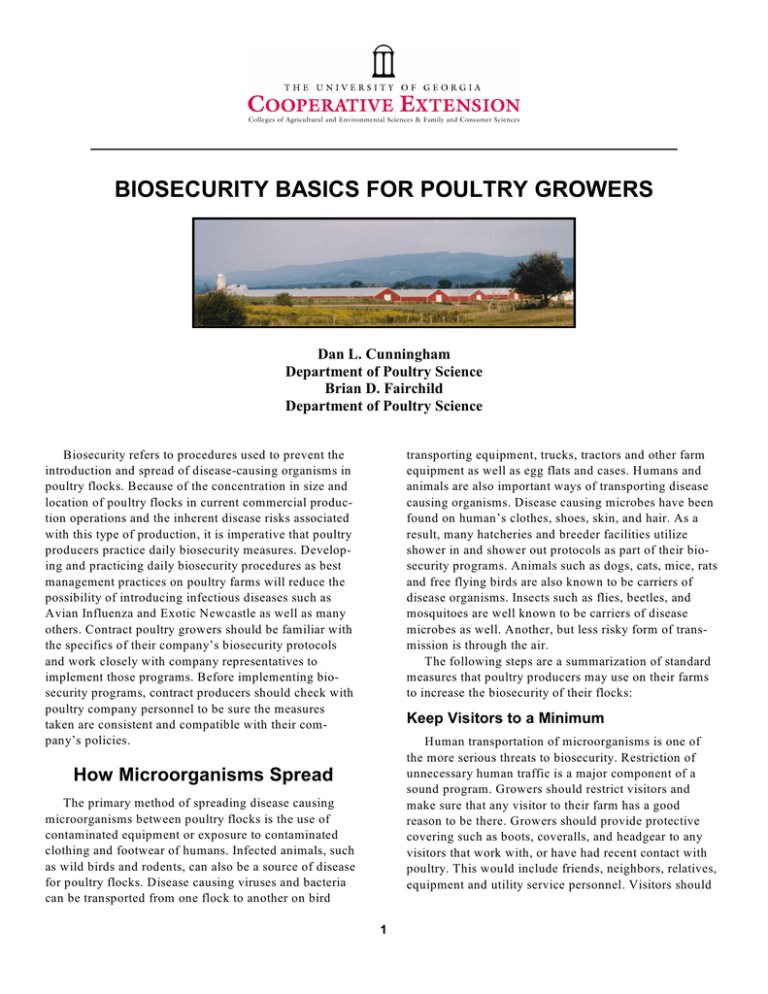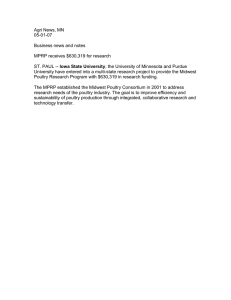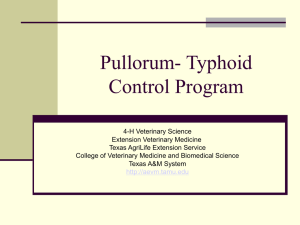BIOSECURITY BASICS FOR POULTRY GROWERS Dan L. Cunningham Department of Poultry Science
advertisement

BIOSECURITY BASICS FOR POULTRY GROWERS Dan L. Cunningham Department of Poultry Science Brian D. Fairchild Department of Poultry Science Biosecurity refers to procedures used to prevent the introduction and spread of disease-causing organisms in poultry flocks. Because of the concentration in size and location of poultry flocks in current commercial production operations and the inherent disease risks associated with this type of production, it is imperative that poultry producers practice daily biosecurity measures. Developing and practicing daily biosecurity procedures as best management practices on poultry farms will reduce the possibility of introducing infectious diseases such as Avian Influenza and Exotic Newcastle as well as many others. Contract poultry growers should be familiar with the specifics of their company’s biosecurity protocols and work closely with company representatives to implement those programs. Before implementing biosecurity programs, contract producers should check with poultry company personnel to be sure the measures taken are consistent and compatible with their company’s policies. transporting equipment, trucks, tractors and other farm equipment as well as egg flats and cases. Humans and animals are also important ways of transporting disease causing organisms. Disease causing microbes have been found on human’s clothes, shoes, skin, and hair. As a result, many hatcheries and breeder facilities utilize shower in and shower out protocols as part of their biosecurity programs. Animals such as dogs, cats, mice, rats and free flying birds are also known to be carriers of disease organisms. Insects such as flies, beetles, and mosquitoes are well known to be carriers of disease microbes as well. Another, but less risky form of transmission is through the air. The following steps are a summarization of standard measures that poultry producers may use on their farms to increase the biosecurity of their flocks: Keep Visitors to a Minimum Human transportation of microorganisms is one of the more serious threats to biosecurity. Restriction of unnecessary human traffic is a major component of a sound program. Growers should restrict visitors and make sure that any visitor to their farm has a good reason to be there. Growers should provide protective covering such as boots, coveralls, and headgear to any visitors that work with, or have had recent contact with poultry. This would include friends, neighbors, relatives, equipment and utility service personnel. Visitors should How Microorganisms Spread The primary method of spreading disease causing microorganisms between poultry flocks is the use of contaminated equipment or exposure to contaminated clothing and footwear of humans. Infected animals, such as wild birds and rodents, can also be a source of disease for poultry flocks. Disease causing viruses and bacteria can be transported from one flock to another on bird 1 Avoid Contact with Non-Commercial Poultry or Wild Birds never enter poultry houses unless approved by the grower or company personnel. Traffic through poultry houses should always flow from younger to older birds. One useful measure is keeping records of visitors that have been on the farm. If a problem arises, knowing who was there will help in limiting additional flock infections. Growers may post signs at the entrance to the farm indicating that entry to the farm and facilities is restricted. Poultry producers work to educate members of the local community of the risks to their flocks and the need to restrict traffic on their farms. This can be done by attending local community meetings or social events and speaking to groups and individuals about this subject. Print an article in the local newspaper about the importance of biosecurity for your farm and others. This can also help educate people regarding the seriousness of this issue. Poultry growers should avoid all contact with noncommercial sources of poultry including backyard flocks, fanciers, fairs, poultry shows, and markets. These types of poultry are seldom fully vaccinated for the major poultry diseases and they are often exposed to many types and flocks of birds. Non-commercial birds represent extremely high-risk contacts. Employees should not be allowed to own their own poultry and neighbors with backyard flocks should be informed of the importance of getting sick or unhealthy birds to a diagnostic lab as soon as possible. Growers should also avoid wild birds such as ducks, geese and turkeys. Growers with farm ponds should be particularly concerned with the potential of carrying droppings from wild birds around ponds into their poultry houses. Wild birds are well known to be carriers of the avian influenza virus as well as other poultry diseases. Hunters should be sure they take the same biosecurity precautions as if they were visiting another poultry farm (i.e. showering, changing clothes, sanitizing vehicles, etc.). Limit Visitations to Other Poultry Farms Poultry growers should refrain from visiting other poultry operations unless absolutely necessary. Whenever it is necessary to visit another farm, growers should be sure to exercise additional precautions such as showering and changing clothes before arriving and washing any vehicle before entering a farm. It will be very important for growers to wear protective clothing including boots, coveralls and headgear and to clean and disinfect all clothing and equipment before returning to their facilities. Showering and changing into clean clothes will also be necessary. Inspect Flocks Daily Growers are required by their contract to inspect their flocks every day. Mortality should be picked up daily and disposed of in a timely and approved method. Stockpiling mortality and allowing carcasses to decompose before disposal increases the risk of spreading disease via rodents and insects. Growers should report increases in mortality or signs of health problems to their service representative immediately. This is required by contract and will ensure a rapid detection and response should a disease be present. Growers should check with their poultry company before using any vaccines, medications or drug treatments for a flock health problem. Timely reporting of health issues on a farm will not only help restrict additional infections, but will minimize losses to both the grower and the company. Keep All Animals Out of Poultry Houses Animals can be carriers of poultry disease causing organisms. Growers should not allow pets such as dogs, cats or other animals in their houses. Some growers will allow their dogs to walk the houses with them, but this is risky because the dogs may have been exposed to other animals or birds that have been contaminated with disease organisms. Poultry houses should be kept as closed as possible to prevent wild birds from getting inside. Wild birds utilizing the feeders and defecating in the houses can be a source of disease. Maximize the Environment Maintaining litter in a relatively dry condition (i.e. 20%-30%) and providing good ventilation will help control microorganism numbers. Wet conditions combined with warm in-house temperatures provide a good growth environment for most disease causing organisms. Good ventilation also helps reduce microorganisms as fresh air entering and leaving the house dilutes microbe populations and removes them from the house. Poor ventilation can result in irritation of the respiratory tract of birds making them more susceptible to bacterial and viral infections. Practice Sound Rodent and Pest Control Programs Rats, mice, and insects such as flies and darkling beetles can carry and spread microorganisms. Growers should consult with their poultry company and practice effective rodent and insect control programs. Eliminating or reducing as many of these pests as possible will reduce the risk of contracting or spreading a disease. 2 Keep Areas Around Houses and Feed Bins Clean Diagnostic Research Center (PDRC), Athens, Georgia. The Georgia Poultry Laboratory Network maintains diagnostic laboratories throughout the state and will assist non-commercial poultry producers with poultry health problems. Locations and phone numbers for the laboratory network and PDRC are listed below: Keeping grass and weeds cut around poultry houses and removing used equipment or trash is beneficial in keeping rodent and insect populations under control. Thick grass or weeds and old equipment provide refuge and habitat for rats, mice and insect pests that can spread disease. Spilled feed should be cleaned up regularly and not allowed to collect for long periods of time. Spilled feed around the feed bins will attract birds, rats, mice and insects. Oakwood, Georgia (770-535-5996) Bowden, Georgia (770-258-0300) Camilla, Georgia (229-336-0001) Canton, Georgia (770-479-2901) Carnesville, Georgia (706-384-2387) Dalton, Georgia (706-278-7306) Douglas, Georgia (912-384-3719) Forsyth, Georgia (478-994-1219) Montezuma, Georgia (478-472-9904) Glennville, Georgia (912-654-0504) PDRC, Athens, Georgia (706-542-5629) Recognizing Disease Symptoms It is important for poultry growers to be aware of signs of disease in their flocks. Early detection of contagious diseases can greatly reduce the impact and spread of that disease to other flocks. Clinical signs associated with the possibility of a disease in a poultry flock are: Summary •Lack of energy and appetite •Decreased egg production •Soft-shelled eggs or misshapen eggs •Swelling of the head, eyes, comb, wattles and hocks •Purple discoloration of the wattles, combs and legs •Nasal discharge •Coughing, wheezing and sneezing •Lack of coordination in mobility •Diarrhea •Sudden or excessive mortality without clinical signs Protecting poultry flocks from microorganism contamination is an extremely important component of commercial poultry production environment. The introduction of a highly pathogenic, contagious disease organism into poultry flocks could result in serious economic consequences for producers. The effectiveness of a biosecurity program can be optimized by regional participation. While any level of biosecurity is helpful, if all poultry producers in a given area utilize best management programs, the program as a whole will be more effective. Practicing sound biosecurity procedures every day as part of a best management program will help reduce the possibility of contracting a disease and will reduce the spread of disease should an outbreak occur. Contract poultry growers should notify a representative of their poultry company immediately if any symptoms of a disease condition is observed. Non-contract producers can contact a poultry veterinarian associated with the Georgia Poultry Laboratory Network or Poultry 3 Bulletin 1306 Reviewed April, 2009 The University of Georgia and Ft. Valley State University, the U.S. Department of Agriculture and counties of the state cooperating. Cooperative Extension, the University of Georgia College of Agricultural and Environmental Sciences, offers educational programs, assistance and materials to all people without regard to race, color, national origin, age, gender or disability. An Equal Opportunity Employer/Affirmative Action Organization Committed to a Diverse Work Force





